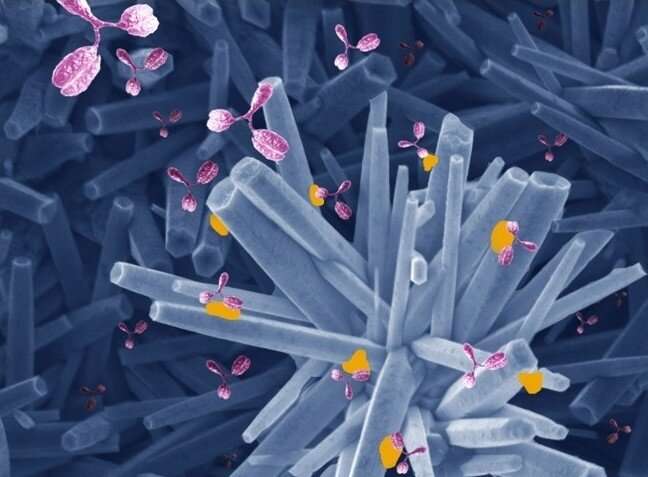Novel device detects COVID-19 antibodies in five minutes

Rapid, cheap and accurate tests continue to be essential for epidemiological surveillance and for health services to monitor and contain the spread of SARS-CoV-2. Brazilian scientists have contributed to endeavors in this field by developing an electrochemical immunosensor that detects antibodies against the virus. The innovation is described in an article published recently in the journal ACS Biomaterials Science and Engineering.
In search of a novel diagnostic method, the group opted for a material frequently used in metallurgy—zinc oxide—and combined it for the first time with fluorine-doped tin oxide (FTO) glass, a conductive material used in electrodes for photovoltaics and other advanced applications.
"With this unusual combination and the addition of a biomolecule, the viral spike protein, we developed a surface capable of detecting antibodies against SARS-CoV-2. The result is displayed as an electrochemical signal captured by this surface," said chemist Wendel Alves, lead author of the article. Alves is a professor at the Center for Natural and Human Sciences, Federal University of the ABC (UFABC), São Paulo state.
The electrode fabricated by the researchers detected COVID-19 antibodies in serum in about five minutes with 88.7% sensitivity and 100% specificity, outperforming even the enzyme-linked immunosorbent assay (ELISA) test, the current gold-standard clinical diagnostic tool.
According to Alves, who heads UFABC's Electrochemistry and Nanostructured Materials Laboratory, prior knowledge of chemical properties such as the isoelectric point of the virus's spike protein (S), enabled the group to develop a platform for S to bind electrostatically to zinc oxide nanorods. Zinc oxide is increasingly used to fabricate biosensors because of its versatility and unique chemical, optical and electrical properties.
The immunosensor is easy to make and use, and its production cost is relatively low. "The group succeeded in developing the device thanks to its strong knowledge of novel materials and zinc oxide nanorod synthesis," Alves said. The nanorods form a film on the FTO's conductive surface, creating a favorable molecular microenvironment for immobilization of the S protein and making the construct a simple way to detect these antibodies.
The researchers will now adapt the platform to make it portable and connectable to mobile devices for use in diagnosing COVID-19 and other infectious diseases.
Analysis and future uses
A total of 107 blood serum samples were analyzed. They were divided into four groups: pre-pandemic (15), COVID-19 convalescents (47), vaccinated without previous positive results for the disease (25), and vaccinated after a positive result (20). The vaccine was two doses of CoronaVac administered four weeks apart. CoronaVac is produced by the Chinese company SinoVac in partnership with Butantan Institute (São Paulo state).
The authors of the article—researchers affiliated with UFABC and the Heart Institute (INCOR), which is run by the University of São Paulo's Medical School (FM-USP)—note that the device detects antibodies produced in response to both infection by the virus and vaccination, and shows excellent potential as a tool for monitoring of seroconversion and seroprevalence. Detecting the response to vaccination is important to help public health authorities assess the effectiveness of different vaccines and of immunization campaigns or programs, they stress.
The device has been validated for detecting immunity induced by CoronaVac, but the group plan to extend its use to testing for the response to Pfizer's and AstraZeneca's vaccines.
One of the advantages of the electrode they developed is its flexible architecture, which means that it can easily be customized for other diagnostic and biomedical applications using different biomolecules on the zinc oxide nanorods and other target analytes.
"The technology is a versatile biosensing platform. As developed by us, it can be modified and customized for serological detection of other diseases of public health interest," Alves said.
More information: Freddy A. Nunez et al, Electrochemical Immunosensors Based on Zinc Oxide Nanorods for Detection of Antibodies Against SARS-CoV-2 Spike Protein in Convalescent and Vaccinated Individuals, ACS Biomaterials Science & Engineering (2022). DOI: 10.1021/acsbiomaterials.2c00509




















